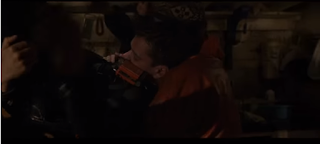A study on gender representations in thriller films with analysis
In thriller movies, there is a clear division between male and female. In most thriller movies, men are the main protagonist that helps save the helpless woman whereby he is strong, protective, good-looking and he's allowed to look at women as an object for e.g. James Bond movies. Whereas, the woman are not independent(they need a masculine figure to survive), they are always the heroine, they are always pretty so they can be used as a object by the male. I will outline the gender representations in different thriller movies.
Firstly, the movie 'Brick' clearly emphasises the stereotypical view of how woman and men should be presented. This is shown at the start of the Thriller opening when the protagonist is praying with his hands clanked together tightly whilst this helpless, dead young female is on the floor, which shows that he feels angry that he failed to protect her perhaps is desire went before his protection for this girl. Similarly, the movie 'Drive' presents the protagonist to be dominant and has all the ultimate power through voice over and very intense music. The car mechanic refers the car as a 'woman' as the car is the protagonist's possession thus emphasising how woman are objects and are men's property.
Moreover, the thriller opening of the movie 'Heat' presents the protagonist to be mysterious as the audience is left with doubts in our mind what he is trying to stop due to the intense music. He obviously has the ultimate power through his gait, facial expressions and body language. This character is known to be one of the typical characters presented in thriller films. Similarly, the
film 'Leon' presents men to deal things quickly through violence and terror, which inevitably makes them evil and dominant. These two movies haven't included women in the Thriller opening sequence, which shows the gender division of roles(Murdock)
Millers Crossing also presents the protagonist to be obsessed with money, and if anyone disrupts their money they would fight back through violence. In this movie, men are presented to be untrustworthy as business deals never has a finished solution but rather one benefits and the other doesn't. Tinker, Tailor, Soldier, Spy also presents their protagonist assessed to finish another man's business through a mission and conspiracy. It presents woman to be helpless as a young woman with a child gets shot but her baby is still alive, which makes us question why.
Whereas, Donnie Darko doesn't have any gender representations in the opening sequence as it presents the main protagonist, which is a male, to be helpless. He is unsure where he is when he is riding his bike but soon becomes more confident like any other person during his journey. This thriller movie opening takes away the stereotype of only woman to be seen as helpless. This movie thriller opening could be compared to 'Brick' as both Donnie Darko and the helpless woman were on the floor, which presents their status in society in some sense or even their authority in society.
Most of these movies identify men as being dominant, strong, brave and intelligent when comes to scenarios that occur. But in my thriller opening sequence we want to break the stereotype however this stereotype must be applied at our thriller opening to give the audience a clear description of how the main protagonist is like. The movie that gave us most inspiration for our thriller opening sequence is Donnie Darko as the main protagonist is helpless and meek but gains his confidence after, which in some sense, is the same for our main protagonist.
The movie Se7en presents male to be helpless and unworthy in the opening sequence through Morgan Freeman's fragile body laying down on the bed whilst he slowly flicks an arrow on a timer that creates tension, whether or not he is worthy of anything. Similarly, the thriller opening sequence of 'Bourne Identity' presents the main protagonist to be worthless and helpless as he is relying on men who bet occasionally to help his health gradually function properly, which makes us question men could be worthless as well as females.
The Thriller Opening Sequence 'The Machinist' presents the main protagonist to be strong, dominant and ruthless as his many scars and cuts in his face or in his body convey this stereotype of male characters being so. However, the opening sequence of the film 'The Silence of the Lambs' presents the female protagonist to be dominant and strong, which most movies do not present thus making the audience wonder why.
These movies from my own research helps me identify how our antagonist in our thriller opening sequence should be like. However, these movies have a clear distinction of the different ways of how men can be seen as dominant. The thriller opening sequence of 'The Machinist' and the 'Silence of the Lambs' give me a clear overview of how our killer, a peculiar antagonist should be presented however the characters don't know who the killer is but we, as the audience, know who the killer is as the killer presents itself at the end of the Thriller opening sequence.
 |
| Medium shot of the movie 'The Silence of the Lambs', which shows this female is not intimidated by these men and she looks a bit manly through her sweatshirt with sweat covered on it. |










No comments:
Post a Comment